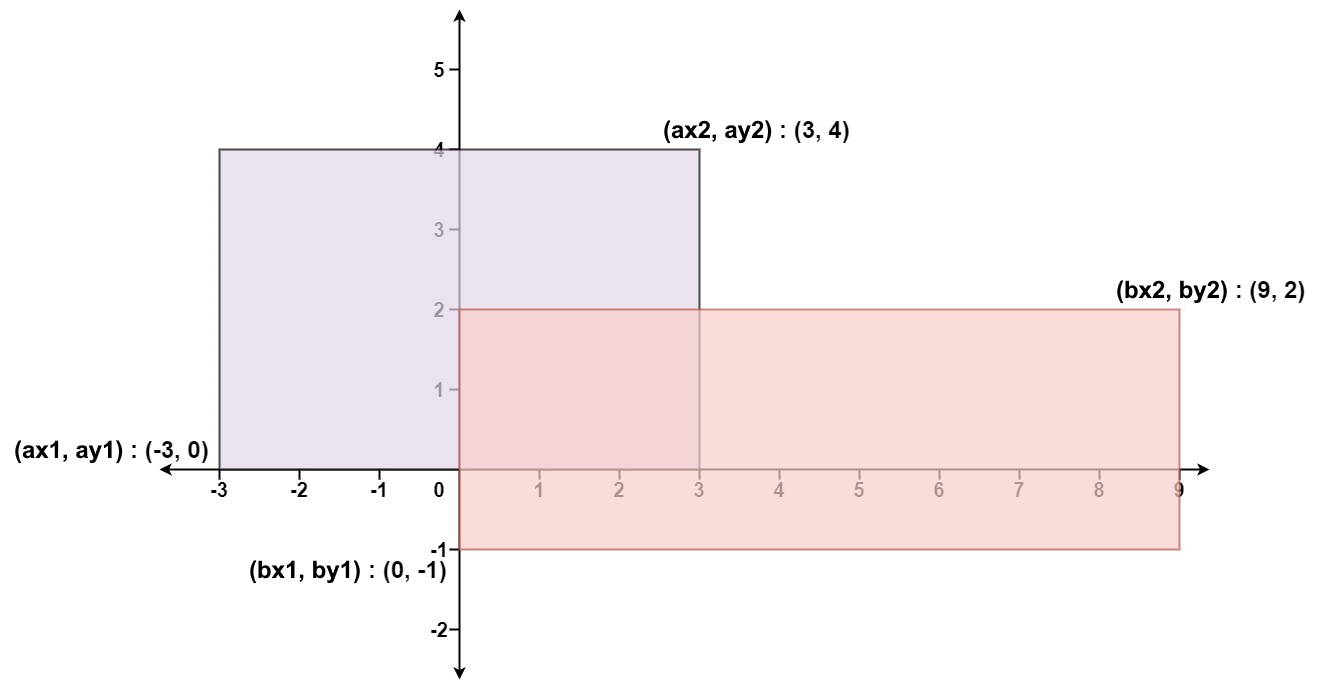Welcome to Subscribe On Youtube
223. Rectangle Area
Description
Given the coordinates of two rectilinear rectangles in a 2D plane, return the total area covered by the two rectangles.
The first rectangle is defined by its bottom-left corner (ax1, ay1) and its top-right corner (ax2, ay2).
The second rectangle is defined by its bottom-left corner (bx1, by1) and its top-right corner (bx2, by2).
Example 1:

Input: ax1 = -3, ay1 = 0, ax2 = 3, ay2 = 4, bx1 = 0, by1 = -1, bx2 = 9, by2 = 2 Output: 45
Example 2:
Input: ax1 = -2, ay1 = -2, ax2 = 2, ay2 = 2, bx1 = -2, by1 = -2, bx2 = 2, by2 = 2 Output: 16
Constraints:
-104 <= ax1 <= ax2 <= 104-104 <= ay1 <= ay2 <= 104-104 <= bx1 <= bx2 <= 104-104 <= by1 <= by2 <= 104
Solutions
Solution 1: Calculate Overlapping Area
First, we calculate the area of the two rectangles separately, denoted as $a$ and $b$. Then we calculate the overlapping width $width$ and height $height$. The overlapping area is $max(width, 0) \times max(height, 0)$. Finally, we subtract the overlapping area from $a$ and $b$.
The time complexity is $O(1)$, and the space complexity is $O(1)$.
-
class Solution { public int computeArea(int ax1, int ay1, int ax2, int ay2, int bx1, int by1, int bx2, int by2) { int a = (ax2 - ax1) * (ay2 - ay1); int b = (bx2 - bx1) * (by2 - by1); int width = Math.min(ax2, bx2) - Math.max(ax1, bx1); int height = Math.min(ay2, by2) - Math.max(ay1, by1); return a + b - Math.max(height, 0) * Math.max(width, 0); } } -
class Solution { public: int computeArea(int ax1, int ay1, int ax2, int ay2, int bx1, int by1, int bx2, int by2) { int a = (ax2 - ax1) * (ay2 - ay1); int b = (bx2 - bx1) * (by2 - by1); int width = min(ax2, bx2) - max(ax1, bx1); int height = min(ay2, by2) - max(ay1, by1); return a + b - max(height, 0) * max(width, 0); } }; -
class Solution: def computeArea( self, ax1: int, ay1: int, ax2: int, ay2: int, bx1: int, by1: int, bx2: int, by2: int, ) -> int: a = (ax2 - ax1) * (ay2 - ay1) b = (bx2 - bx1) * (by2 - by1) width = min(ax2, bx2) - max(ax1, bx1) height = min(ay2, by2) - max(ay1, by1) return a + b - max(height, 0) * max(width, 0) ############ class Solution(object): def computeArea(self, A, B, C, D, E, F, G, H): """ :type A: int :type B: int :type C: int :type D: int :type E: int :type F: int :type G: int :type H: int :rtype: int """ area = (C - A) * (D - B) + (G - E) * (H - F) overlap = max(min(C, G) - max(A, E), 0) * max(min(D, H) - max(B, F), 0) return area - overlap -
func computeArea(ax1 int, ay1 int, ax2 int, ay2 int, bx1 int, by1 int, bx2 int, by2 int) int { a := (ax2 - ax1) * (ay2 - ay1) b := (bx2 - bx1) * (by2 - by1) width := min(ax2, bx2) - max(ax1, bx1) height := min(ay2, by2) - max(ay1, by1) return a + b - max(height, 0)*max(width, 0) } -
function computeArea( ax1: number, ay1: number, ax2: number, ay2: number, bx1: number, by1: number, bx2: number, by2: number, ): number { const a = (ax2 - ax1) * (ay2 - ay1); const b = (bx2 - bx1) * (by2 - by1); const width = Math.min(ax2, bx2) - Math.max(ax1, bx1); const height = Math.min(ay2, by2) - Math.max(ay1, by1); return a + b - Math.max(width, 0) * Math.max(height, 0); } -
public class Solution { public int ComputeArea(int ax1, int ay1, int ax2, int ay2, int bx1, int by1, int bx2, int by2) { int a = (ax2 - ax1) * (ay2 - ay1); int b = (bx2 - bx1) * (by2 - by1); int width = Math.Min(ax2, bx2) - Math.Max(ax1, bx1); int height = Math.Min(ay2, by2) - Math.Max(ay1, by1); return a + b - Math.Max(height, 0) * Math.Max(width, 0); } }